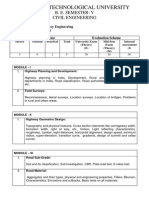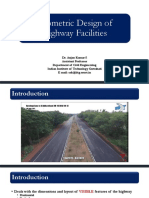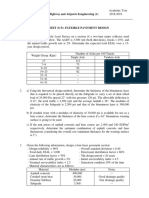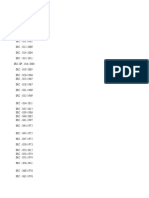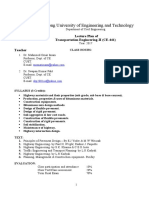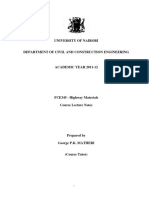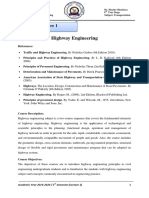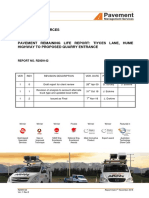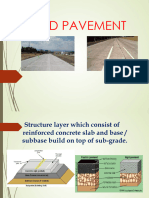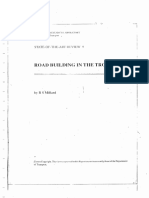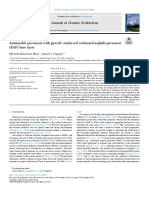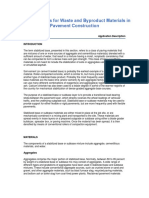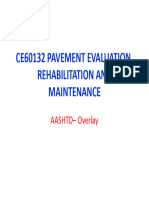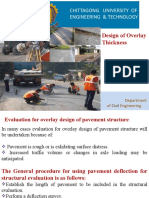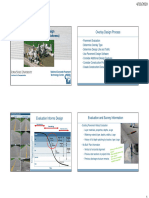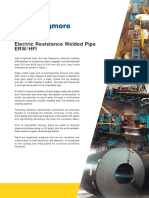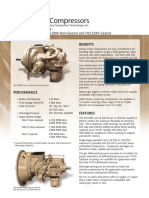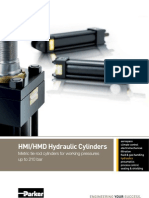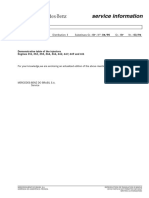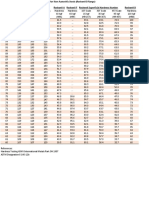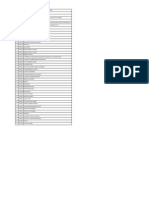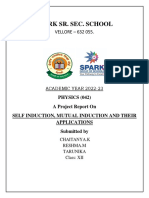Structural Overlay Design Using NDT Methods
Zhong Wu, Ph.D., P.E. Louisiana Transportation Research Center 2007 Transportation Engineering Conference Baton Rouge, February 11-14, 2007
�Outline
Background Objective Overview of Overlay Design Methods Research Projects Summary Recommendations
�Background
Asphalt overlay has been considered as
simplest and fastest means of restoring the distressed surfaces of rigid and flexible pavements
A quality overlay design
improve the roadways rideability restore the pavement structural stability.
Existing subgrade condition Existing pavement strength Engineering judgment
Structural overlay thickness design requests
�Background (cont)
Current DOTD overlay thickness design
the 1993 AASHTO Pavement design guide software (DARWin)
One required design input, subgrade resilient modulus value, Mr,
the pre-assigned parish-map values not base on in-situ soil properties
Uses component analysis (layer co-efficients) method to determine the existing pavements structure number SNeff = aihi Such method can lead to design errors (over- or underestimated overlay thickness)
since design values do not represent actual field conditions
�Overlay Design Example
150
Typical pavement section Hot mix asphalt D1=102 mm, a1=0.0165/mm Base course D2=241 mm, a2=0.0063/mm Subbase D3=457 mm, a3=0.0040/mm Subgrade soil
100
Difference in overlay thickness (mm)
Mr = 2,000 psi => Underestimated AC thickness of 1.5 in
50
0 -30 -20 -10 -50
10
20
30
40 50 60 70 80 Change in Mr (MPa)
Mr = -2,000 psi => Overestimated AC thickness of 2.0 in
-100
W18=5,000,000 ESALs R=95 % PSI=1.9 S0=0.35 Design Mr=34.5 MPa Design SN=5
-150 -4000 -2000
2000
4000
6000 8000 10000 Change in Mr (psi)
�Objective
to establish a methodology for mechanistic pavement overlay design, based on
in-situ pavement conditions, and utilizing non destructive test (NDT) methods, specifically the FWD and/or Dynaflect.
Dynatest 8002 model Falling Weight Deflectometer
Dynaflect
�Overview of Overlay Design Methods
Effective Thickness (ET) Approach
1993 AASHTO Pavement Design Guide Asphalt Institute (AI) ET Method (MS-17) AI Benkelman Beam Deflection Method (MS-17) Caltran Flexible Pavement Rehabilitation EVERPAVE (WsDOT) New M-E Pavement Design Guide
Deflection-based Approach
Mechanistic-Empirical (M-E) Approach
�Effective Thickness (ET) Approach - Asphalt Institute (MS-17)
Thickness of Overlay = Tn - Te
Tn, new pavement thickness, determined from AI Design Chart for Full-depth Asphalt Concrete, using ESALd and Mr Te, effective thickness of existing pavement structure Te= Cihi
where, hi=thickness of the ith layer of the existing pavement; Ci=conversion factor associated with the ith existing layer
�Effective Thickness (ET) Approach -1993 AASHTO Pavement Design Guide
Overlay Thickness Equation
hOL SNOL aOL SN f SNeff aOL
SNf from AASHTO pavement design equation where Mr is a required input, which can be determined from
Laboratory Testing Backcalculation from NDT measurements Approximate relationships (used by DOTD) NDT method Component analysis method (used by DOTD) Remaining life method
The effective structure number of existing pavement, SNeff
�Deflection-Based Approach - Asphalt Institute Benkelman Beam (MS-17)
Pavement is modeled as a two-layer system
Layer 1: AC Overlay Layer 2: Existing pavement
Overlay thickness is determined as following steps:
Determine Representative Rebound Deflection (RRD)
Layer 2s elastic modulus is determined from RRD.
Compute Design Rebound Deflection (DRD) based on the allowable ESAL: DRD=1.0363 (ESAL)-0.2438
Other Deflections (e.g. FWD, Dynaflect) can be converted into Benkelman beam deflections, such as
Benkelman Beam = 1.61 * FWD Benkelman Beam = 20.63 * Dynaflect
�Mechanistic-Empirical (M-E) Approach
Modeled pavement as multi-layered elastic or visco-elastic structure Pavement materials described by their stiffness and strengths at different times of the year Determine the critical stress, strain, or deflection by mechanistic methods Predict resulting damages by empirical failure criteria, e.g. fatigue cracking, rutting.
�Mechanistic-Empirical (M-E) Approach -EVERPAVE
Developed by Washington DOT Steps:
Backcalculate layer moduli using FWD data Analyze and determine the two failure criteria parameters.
Fatigue cracking Rutting
log N f 14.82 3.291log( t ) 0.854log(Eac )
log N f 1.077 1018 ( V ) 4.4843
Compute allowable repetitions to failure at each season Compute damage at each season and sum the seasonal damage ratio. Determine the overlay thickness based on the sum of the damage ratio is less than or equal to one.
�EVERPAVE Design Input
�New M-E Pavement Design Guide
Developed under NCHRP 1-37A New Traffic input Enhanced Integrated Climatic Model (EICM)
Season variations
New Distress Models Need Calibration
Dr. Matthew W. Witczak (2003)
�NDT Overlay Design Survey
State Arkansas Mississippi Alabama Maryland Virginia California North Carolina South Carolina Idaho Minnesota Oregon Texas Washington Method Equivalent Thickness Equivalent Thickness 1993 AASHTO 1993 AASHTO 1993 AASHTO Deflection-based AI Deflection-based Deflection-based M-E M-E M-E M-E M-E ELMOD5 Spreadsheet program Spreadsheet program (VDOT) Spreadsheet program Design Manual Spreadsheet program Spreadsheet program WinFlex MNPAVE / FPS-19W EVERPAVE Software ROADHOG
�Project Selection
Four in-service pavements
I-12 (ESALd=24,400,000, life=15yrs) LA28 (ESALd=1,513,000, life=10yrs) LA74 (ESALd=700,590, life=10yrs) LA44 (ESALd=353,256, life=10yrs)
Each project about 3 to 5 miles long
�Design Plan
Based on current DOTD overlay design method (Mr-parish map, SNeff-estimated)
I-12 4.5 AC overlay + 2 cold planning LA28 4.5 AC Overlay + 2 cold planning LA44 3.5 AC overlay + 2 cold planning LA74 3.5 AC overlay + 2 cold planning
�NDT Tests
FWD and Dynaflect tests were performed on each project site
at 0.1 mile interval on both traffic directions
FWD Load
8 4 6 6 12 12 12 12
d1
d2
d3
d4
d5
d6
d7
d8
d9
�Dynaflect Deflection Analysis
Kinchen and Temple (1980) developed a Pavement Evaluation Chart for Louisiana
SN of existing pavements Subgrade Modulus
Routinely use in pavement research projects
Pavement Evaluation Chart
�FWD Deflection (mils)
10
20
30
40
50
0
0.1 0.3 0.5 0.7 0.9 1.11 1.3 1.5 1.7 1.9 2.1 2.3 2.5 2.7 2.9 3.1
LA 74
FWD Analysis (D0 & D9)
Station (miles)
FWD Deflection (mils)
D1 (EB) D0 (W B) D9 (EB) D9 (W B)
10
15
20
25
0
1.0 1.2 1.4 1.6 1.8 2.0 3.1 3.3 3.5 3.7 3.9 6.0 6.2 6.4 6.6 6.8 7.0
LA 44
Station (miles)
D9 (SB)
D0 (SB)
D9 (NB)
D0 (NB)
�Dynaflect (SN)
�Overlay Thickness
Deflection-Based Approach (AI Method)
8
Overlay Thickness (in)
6 4.5" 4 3" 3" 2" 2 0 I-12 LA28 Project 4.5" 4.5" 3.5" 4"
Current Plan AI (NB/EB) AI (SB/WB)
3.5" 3" 2" 2"
LA74
LA44
�Equivalent Thickness Method (Arkansas ROADHOG)
8
Overlay Thickness (in)
Current Plan ROADHOG(NB/EB) ROADHOG(SB/WB)
6 4
4.5"
4.5" 4.2" 3.5" 2.7" 2.9" 2.2"
3.5" 2.8" 2.6"
2" 2" 2 0 I-12
LA28 Project
LA74
LA44
�Based on M-E Design Approach
Only 0 or 1 overlay thickness required for all four projects. Possible explanations:
Backcalculated modulus too high Default values used in distress models (no Calibrated) Not fully understand how to choose a representative design value
�Summary (Deflection-based method)
Simple to use (e.g. AI method) Needs to verify and calibrate the relationship between FWD (or Dynaflect) measured deflections and BB rebound deflections Relationship between allowable rebound deflection and ESALd also needs to be verified and calibrated
�Summary (Equivalent Thickness method)
Simple to use (e.g. AASHTO and ROADHOG) 1993 AASHTO NDT-based method generally underestimate the overlay thickness, due to overestimate the existing pavement SN. ROADHOG uses its own relationship in estimation of SNeff.
Such relationships between SNeff and delta(D) may or may not be applicable to Louisiana condition
�Summary (M-E design method)
Complicate to use. M-E-based overlay design method needs sophisticate inputs, which usually are not available directly from in-situ NDT tests The fatigue and rutting models used in any ME base design software must be verified and calibrated before any locally implementation.
�Proposed NDT-based Overlay Design Procedure for Louisiana
Use Effective Thickness approach The future Structure Number (SNfuture) determined from 1993 AASHTO design equation
Mr determined from in-situ tests (DCP, FWD or Dynaflect) If FWD used, SNeff (FWD) needs to be scaled down to SNeff (Dynaflect) for Louisiana Condition
SNeff determined from FWD or Dynaflect test
Overlay thickness = (SNfuture-SNeff)/aAC
�Future Works
Further validate the Dynaflect deflection determined SNeff The proposed overlay design procedure will be automated into a EXCEL spreadsheetbased program




